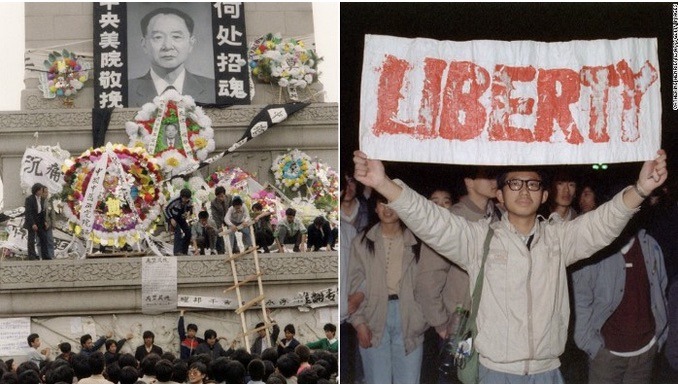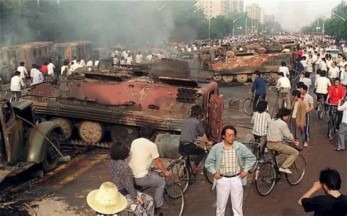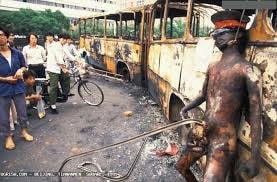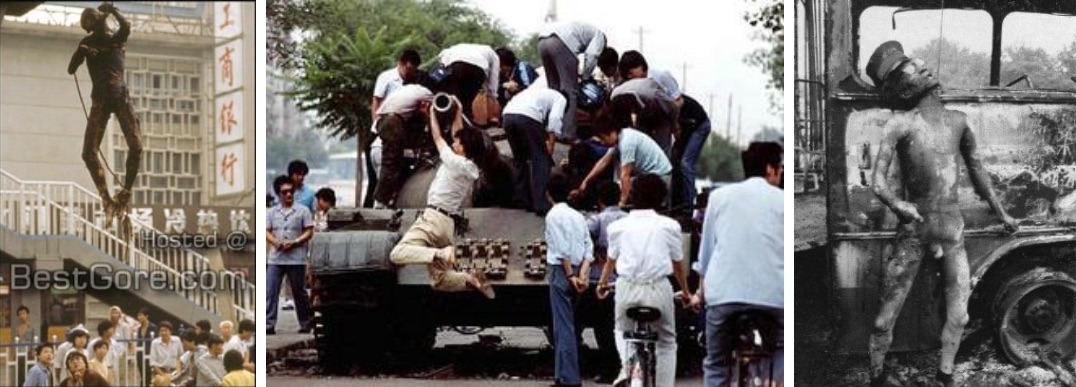Notes for 30th Anniversary of TianAnMen Incident
 Editor's Note: The original version of this article on Medium has contextually important pictures we are not able to reproduce here due to copyright issues.
Editor's Note: The original version of this article on Medium has contextually important pictures we are not able to reproduce here due to copyright issues.

No accident that the center piece of the protests was a replica of the Statue of Liberty. The statue was brought into the square in segments and finished on the site. (TGP screengrab from video)
[dropcap]M[/dropcap]any socialist states collapsed in the late 80s and early 90s, succumbed to pressure and sabotage from hostile bourgeois states, torn apart, cannibalised over night, and became vassals of the global neo-liberal order, dooming entire populations to poverty and misery: Yugoslavia, USSR, GDR, etc. The same fate was planned for China, but the Communist Party was able to defeat the counter-revolution, and the country has remained independent to this day.
Deng XiaoPing was ill by 1989, and his imminent exit from office was soon to create a power vacuum. The CIA already had their man inside the party, Zhao Ziyang, who, if the student protests had spread and succeeded, would have taken power, opened the doors to imperialist domination, and ended Chinese socialist sovereignty.
In the 1980s, the economic plan put in place by Deng Xiao Ping had been focusing on the growth of rural/inland regions, in order to overcome the very serious problem of uneven development (urban/coastal regions had been growing much faster). As a result, urban development temporarily stagnated — economic discontent resultant from this and grievances over other developmental problems such as corruption formed the initial and underlying catalyst for the protest movements.
“The student leadership was smart: They seized on the issue of corruption, not economic or political conservatism, as their focus. This was something that ordinary people could also latch onto. The students could cloak themselves in the legitimate, patriotic mourning of a fallen Party leader, and could build the momentum without the Party leadership being able to do anything about it. …
it’s important, I think, to understand the almost absurdly unlikely convergence of factors that made protests of this size at all possible. They were, many who have studied the protests would concur, all out of proportion to the size of the initial grievance. The tinder was damp, and yet it caught fire.”
–– The Unlikely Confluence Of Events That Led To The 1989 Tiananmen Square Protests
The “National Endowment for Democracy” had been funding the student protestors since at least 1985, fanning the flames of the most extremist anti-government sentiments, and set up radio stations to disseminate anti-socialist and liberal capitalist propaganda (no accident that the center piece of the protests was a replica of the Statue of Liberty). It was the tried and true formula that had been deployed countless times during the 20th Century against disobedient states, most recently in Syria, Libya, Venezuela, etc.: fan the flames of uprisings, derail them, and use the ensuing chaos to destabilise, create chaos, and topple governments resistant to Western hegemony.
The CPC rightly suppressed those astro-turf “pro-democracy” elements, because they were supported by and served bourgeois interests, with the goal of ending Chinese self determination, so Western powers can once again reclaim the slave country which once belonged to them.
“…a major blowout in the leadership, which led to Zhao-type forces taking over the CPC is unlikely unless the rightists can put together some unholy alliance with dissident military forces, of which there are not many. This means that we can expect some continuity and that the bulk of leadership will remain committed to carrying the socialist project through to its completion.”
– Looking back at Tiananmen Square, the defeat of counter-revolution in China
But to date, there is not a single shred of photographic, video, or any other kind of evidence for the “hundreds”, “thousands”, or “tens of thousands”, of protesters “massacred” by gun fire or tanks by the government in or around the square that night or any of the other days during the uprising. To those who hold up the few photos which exist of a few on stretchers, bleeding on the ground, or deceased, I respond: How many died at the German Techno-Rave party Love Parade in 2010? The dangers of injuries or casualties exist during any very crowded large scale public event, and especially during political uprisings. There were many foreign journalists present, why is there not a single photo of the “massacre”? How ever, there is evidence that most of the injured and casualties were soldiers and workers, and very few students.
CBS News: There Was No “Tiananmen Square Massacre”
Contrary to what this CBS News article claims, there is also no evidence of government mass-killings around the square, only casualties resulting from conflict, people trampled by crowds, other kinds of accidental deaths, and soldiers killed by protestors.
“Secret cables from the United States embassy in Beijing have shown there was no bloodshed inside Tiananmen Square when China put down student pro-democracy demonstrations 22 years ago.”
– Wikileaks: no bloodshed inside Tiananmen Square
“The problem is this: as far as can be determined from the available evidence, no one died that night in Tiananmen Square.”
“The demonization of China was highly effective. Nearly all sectors of U.S. society, including most of the “left,” accepted the imperialist presentation of what happened.
At the time the Chinese government’s official account of the events was immediately dismissed out of hand as false propaganda. China reported that about 300 people had died in clashes on June 4 and that many of the dead were soldiers of the Peoples Liberation Army. China insisted that there was no massacre of students in Tiananmen Square and in fact the soldiers cleared Tiananmen Square of demonstrators without any shooting.
The Chinese government also asserted that unarmed soldiers who had entered Tiananmen Square in the two days prior to June 4 were set on fire and lynched with their corpses hung from buses. Other soldiers were incinerated when army vehicles were torched with soldiers unable to evacuate and many others were badly beaten by violent mob attacks.
These accounts were true and well documented. It would not be difficult to imagine how violently the Pentagon and U.S. law enforcement agencies would have reacted if the Occupy movement, for instance, had similarly set soldiers and police on fire, taken their weapons and lynched them when the government was attempting to clear them from public spaces. …
What happened in China, what took the lives of government opponents and of soldiers on June 4, was not a massacre of peaceful students but a battle between PLA soldiers and armed detachments from the so-called pro-democracy movement. …


The goal of the U.S. government was to carry out regime change in China and overthrow the Communist Party of China which had been the ruling party since the 1949 revolution. …
In the case of the “pro-democracy” protests in China in 1989 the U.S. government was attempting to create a civil war. The Voice of America increased its Chinese language broadcasts to 11 hours each day and targeted the broadcast “directly to about 2,000 satellite dishes in China operated mostly by the Peoples Liberation Army.”
This episode should be seen in a larger historical context of ceaseless Western sabotage and destabilisation efforts from any possible angle, since at least the 1940s:
CIA’s War Against China
And it is important to remember, while this base-less allegation has saturated global media to slander the CPC, the South Korean capitalist military dictatorship massacre of 600+ student protestors in 1980, an event for which every evidence exists, is never ever even mentioned in Western press:
“Estimates suggest up to 606 people may have died.[4] During this period, Gwangju citizens took up arms (by robbing local armories and police stations) when local Chonnam University students — who were demonstrating against the martial law government — were fired upon, killed, and beaten by government troops.
During Chun Doo-hwan’s presidency, the authorities used to define the incident as a rebellion instigated by Communist sympathizers and rioters.[9] By 1997, a national cemetery and day of commemoration (May 18), along with acts to “compensate, and restore honor” to victims, were established.”
I was 15 at the time, politically ignorant, and being under the sway of my reactionary parents, joined the “pro democracy” demonstrations from the US –– something of which I am today ashamed.
Four Myths of TianAnMen / Robert K Tan
When history writes the final version, the Tiananmen turmoil of 1989 will be seen as a Chinese tragedy that was hugely exaggerated and skewed by ill-wishers of the People’s Republic to discredit and demonize socialist China. It is also one of the great propaganda hoaxes of modern times (see link at bottom). Here are the core myths surrounding the episode — and the corresponding realities:
MYTH 1: Thousands of unarmed student protesters at Tiananmen Square were mowed down by machine guns and crushed by tanks of the Chinese army PLA in the early hours of June 4, 1989.
REALITY: No one was killed in Tiananmen (TAM) Square in the early morning of June 4, 1989. Secret cables from the American ambassador in China, James Lilley, to the US State Department published by Wikileaks in June 2011 unequivocally affirmed the fact. The cables were based on an eyewitness account by Chilean second secretary in China, Carlos Gallo, who was at the square until he left with the last students that morning. “Once agreement was reached for the students to withdraw,” said Lilley in his cable, “the students left the square through the southeast corner. Essentially everyone, including Gallo, left. The few that attempted to remain behind were beaten and driven to join the end of the departing procession.”
One other source has confirmed the Chilean diplomat’s account. That was Eugenio Bregolat, Spain’s ambassador to Beijing at the time. In a book he wrote about Tiananmen, he angrily denies the massacre stories. He notes that Spain’s TVE channel had a television crew in the square most of the evening, and that if there had been a massacre, they would have been the first to see it and record it. He points out that most reports of an alleged massacre were made by journalists hunkered down in the safe haven of the Beijing Hotel, some distance from the square.
A Taiwan-born singer and composer, Hou Dejian, who joined the student protesters at the square and negotiated with the Chinese army commissar for the remaining students to leave it, said categorically that there were no killings in the early morning of June 4. He stayed at the square until 6:30, after all the students had left. Hou told a press interviewer: “During the whole withdrawal process I didn’t see a single student, citizen or soldier killed in the square. Nor did I see any armored personnel carriers rolling over people.”
MYTH 2: After Wikileaks’ release in 2011 of diplomatic cables from the Beijing US embassy to the State Department stating that no one was killed at Tiananmen Square, a revised narrative appeared: Thousands of unarmed civilians, including students, died after being fired upon by tanks and armed PLA soldiers in the streets leading to the square.
REALITY: On June 2 and 3, buses carrying PLA soldiers and armored personnel carriers were attacked by rioters with Molotov cocktails or petrol bombs. Hundreds of buses and APCs were torched. Dozens of soldiers were burnt to a crisp in the buses, and a few corpses were strung up in the streets. The rioters set up barricades and roadblocks by burning buses or armored carriers.
Reinforcements of armed soldiers had little choice but to fire on the rioters carrying Molotov cocktails and even guns, in self-defense and to clear the streets leading to the square. Most of the rioting and bloodletting took place in Muxidi, about 3 km west of TAM Square. The official figure was around 300 dead, some 40 of whom were students. Most of the others were PLA soldiers, workers and rioters. More than 3,000 soldiers were injured.
MYTH 3: The seven-week long occupation of Tiananmen Square was a spontaneous protest by students against corruption and lack of transparency in the Chinese government, with no involvement by foreign organizations.
REALITY: The demonstrations might have begun spontaneously as a result of popular frustration and even anger at increasing corruption. Soon enough, however, foreign involvement became apparent. Said a report in the Vancouver Sun, attributed to AP: “For months before the June 3 attack on the demonstrators, the CIA had been helping student activists form the anti-government movement, providing typewriters, facsimile machines and other equipment to help them spread their message, said one official. The CIA declined all comment.”
The “equipment” provided by CIA likely included the Molotov cocktails used by rioters, or their main ingredient, petrol, which was strictly rationed in Beijing at the time and unavailable to ordinary people. Prior to the days leading up to June 4, they had never been seen or used in China.
Lilley, America’s China ambassador before and throughout the TAM incident, was a veteran CIA officer who had served as a senior East Asia expert in the Reagan administration. He grew up in China and could speak native-level Chinese. He was thus well placed to spearhead a “color revolution” in China. Voice of America stepped up its Chinese language broadcasts from Hong Kong to China to 11 hours a day in the weeks leading to June 4. Many students at TAM Square tuned in to the US government station as a “reliable” source of news. VOA made provocative statements and dispensed advice to student demonstrators about their protests. In the final few days, VOA disseminated false rumors of Li Peng’s arrest, Deng Xiaoping’s near-death, and infighting among PLA factions.
George Soros’ Fund for the Reform and Opening of China was allowed to operate in the country from 1984. The fund promoted cultural exchanges and sponsored research projects in conjunction with China’s Institute for Economic Structural Reform, an influential liberal think-tank supported by Communist Party chief Zhao Ziyang. Allegations that the China Fund was a CIA tool had surfaced in Washington two years before. Moreover, the US National Endowment for Democracy had two offices in China, which conducted regular seminars on democracy. It also sponsored Chinese writers and publications.
So the usual suspects of Washington-instigated color revolutions were present and operating in China prior to June 4, 1989. A known VOA representative was filmed talking to student protest leader Chai Ling in TAM Square, in breach of the martial law declared in Beijing.
"Give me freedom or give me death!"
"Hungry for Democracy!"
From the start, US style liberalism was at the core of the protest movement
MYTH 4: The Chinese government made a big mistake in suppressing the student protests. China would have been better off today practicing the Western model of democracy.
REALITY: The agenda of the student leaders was to topple the Communist Party. Chai Ling said as much in a press interview years later in America, where she fled to.
There would have been a power vacuum had the CPC been overthrown, giving the Empire an opening to install a friendly leadership amenable to its wishes. In fact, party general secretary Zhao Ziyang was Washington’s bet in Beijing. In his memoirs Zhao expressed support for democracy and multiparty elections, separation between the state and the party, and neoliberal economics such as privatization of state-owned enterprises. Lionized by Western media as a “liberal reformist,” he was dubbed China’s Gorbachev — and Yeltsin to boot.
China could well have disintegrated under Zhao, as the USSR did under Gorbachev. Zhao’s neoliberal economic policies would likely have resulted in the wholesale plunder of state assets, as with Russia under Yeltsin. China could have become a de facto vassal state of America. The impending return of Hong Kong and Macau to China would have been dead before arrival, and Taiwan might have declared independence. The secession of Xinjiang and Tibet would have been on the cards.
China and its people today have much to thank Deng for. He saw through the Empire’s design to split and recolonize his country. With Deng’s decisive steps to end the Tiananmen turmoil, China was able to retain its sovereignty and preferred course of market socialism. The Western sanctions and temporary disruption to his reforms were a small price to pay.
Make no mistake, 1989 was a close call, and China had barely avoided the fate of the USSR
Professor Dennis Etler commenting on the imperialist article An Alternative History for China:
“Well, David Shambaugh is at it again tooting Zhao Ziyang’s horn. Shambaugh fulling acknowledges that Zhao was China’s Gorbachev, but that’s all good. According to him China would be a better place if Zhao’s neo-liberal economic and political reforms had been enacted. To quote:
“Had Zhao remained in power and been able to pursue this twin-reform strategy, it is an open question whether he and China would have wound up with the same fate as Gorbachev and the former Soviet Union, or whether this strategy would have worked in China, where it did not in the U.S.S.R.”
But, as far as the US and the West in general is concerned the strategy did work in the USSR. And, they would have done everything possible to have made sure it worked in China as well if Zhao had implemented his counter-revolutionary agenda.
Luckily the “éminences grise” of the CPC were able to thwart the machinations of Zhao’s puppet-master George Soros of color revolution fame.
What would China be like today if Zhao Ziyang had retained power? It would be a compliant vassal of the US in East Asia.
As Shambaugh et al. state, China would be a “much more open civil society and media (i.e. controlled by US neo-liberal NGOs and corporate conglomerates); tolerated some dissent (i.e. anti-communist quislings); enfranchised the eight so-called “democratic parties” (i.e. allowing them to be infiltrated by foreign agents) and empowered the National People’s Congress and provincial people’s congresses (i.e. destroying China’s system of consensual democracy); established a Hong Kong-style professional civil service (Zhao studied this carefully and was embarked on this reform when he was overthrown) (i.e. allowing anti-communist sinecures to metastasize within the state apparatus); separated Party from government (dang-zheng fenkai)(i.e. ensuring the collapse of Party control and the establishment of an oligarchic “representational democracy”); made the military beholden to the state and constitution rather than as a tool of the Communist Party (i.e. undermining China’s state sovereignty); more strictly controlled opportunities for corruption and strengthened the non-Party control mechanisms (i.e. by making corruption an integral part of the system as in the US and other Western democracies); encouraged greater “inner Party” feedback mechanisms (i.e. encouraging factionalism); and (finally) proceeded with gradual direct government elections up to and including central-level officials (i.e. allowing politicians to be bought and sold to the highest foreign bidder). In other words a neo-liberal’s, such as Shambaugh, wettest dream.”
The battle against the Big Lie killing the world will not be won by you just reading this article. It will be won when you pass it on to at least 2 other people, requesting they do the same.
The best way to get around the internet censors and make sure you see the stuff we publish is to subscribe to the mailing list for our website, which will get you an email notification for everything we publish.
 He Zhao • Insurrectionary Rhythm, Radical Hedonism, Egalitarian Sexuality: Make Raves Marxist Again
He Zhao • Insurrectionary Rhythm, Radical Hedonism, Egalitarian Sexuality: Make Raves Marxist Again

THIS WORK IS LICENSED UNDER A Creative Commons Attribution-NonCommercial 4.0 International License








